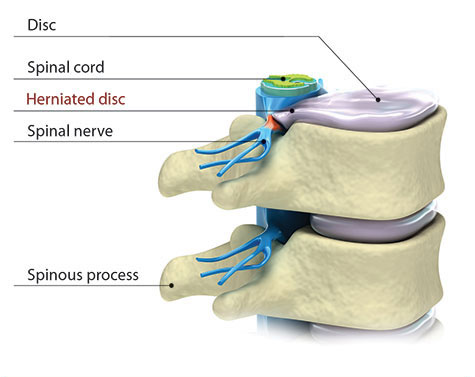
Learn about the shock-absorbing discs that separate the bones in the spine.
![]() Select from the following links to learn more about Scoliosis.
Select from the following links to learn more about Scoliosis.
Scoliosis Overview | Adult Scoliosis | Pediatric Scoliosis | Flatback Syndrome | Surgical Options | Minimally Invasive Scoliosis Surgery | Harrington Rod | Lordosis | Kyphosis | Helpful Links
The most common type of scoliosis is adolescent idiopathic scoliosis (AIS). Recently, researchers have determined that this type of scoliosis is genetic or heritable. Texas Spine and Scoliosis now offers a genetic test called ScoliScore that can predict genetic predisposition for progression in adolescents.
Scoliosis is a curvature of the spine that can first appear during childhood. Some people are born with it, while others develop it over time. Scoliosis can cause the spine to twist and bend in an abnormal way. The cause of scoliosis is unknown, but it does tend to affect more women than men.
It is very important to individually assess cases of scoliosis. Sometimes a back brace is used to prevent worsening of the spine curvature. Adolescent scoliosis can progress even after skeletal maturity, if the curvature is larger than 40 degrees in the thoracic spine or larger than 30 degrees in the lumbar spine, the scoliosis should be monitored about every 5 years if no symptoms are present.
Dramatic curves of the spine can place pressure on internal organs. If this happens, surgery may be necessary. If left untreated, severe cases of scoliosis can shorten a person's life span.
In less
severe cases, scoliosis may cause the bones to twist slightly, making
the hips or ribs appear uneven. When this occurs, the problem is
more cosmetic and less of a health risk.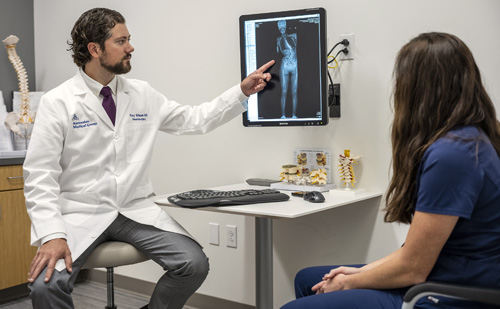
Scoliosis surgery is extremely complex, and a person should invest a great deal of time in choosing an orthopedic surgeon who uses the most current surgical fixation rods. If a surgeon uses improper methods during scoliosis surgery, the patient could become paralyzed.
[Top]
The exact cause of scoliosis is unknown. Only 1-4 percent of the population
has this condition. It is more common in women than men, about 10:1, and most
often affects adolescents between the ages of 10 and 18. A child's
likelihood to develop scoliosis is much higher if their parent or
a sibling has it. Scoliosis can also develop over time in mid- to
late childhood, usually before puberty. In other cases, the disease
is congenital, meaning a person is born with a vertebral abnormality
that causes it.
[Top]
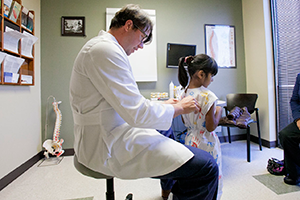 Sometimes, the symptoms of scoliosis are visible. For instance, the
child may have uneven shoulders, chest, hips, shoulder blades, waist,
or a child may have a tendency to lean to one side. In other cases,
there are no visible symptoms.
Sometimes, the symptoms of scoliosis are visible. For instance, the
child may have uneven shoulders, chest, hips, shoulder blades, waist,
or a child may have a tendency to lean to one side. In other cases,
there are no visible symptoms.
Usually noticed by a family member, pediatrician, family physician, or school screening.
If the curve grows to greater than 40-45 degrees lumbar, or 45-50 degrees thoracic, then surgery may be recommended. To diagnose a child with scoliosis,
have them touch their toes. If either one or both shoulder blades
are prominent, the waist is shifted or ribs are uneven, scoliosis
may be present. For a child or teenager, your pediatrician often
screens for scoliosis. There are school screening programs as well.
[Top]
Outlined below are some of the diagnostic tools that your physician may use to gain insight into your condition and determine the best treatment plan for your condition.
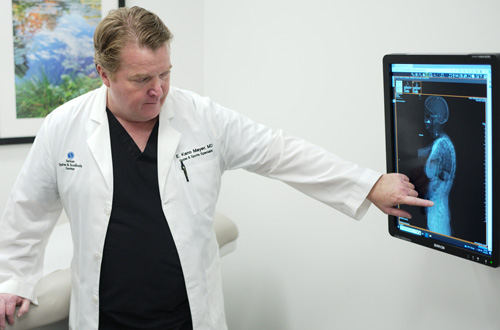
There are roughly three tiers of treatment for adolescent scoliosis. However, scoliosis can cause pain in 20 to 30 year olds as well. Conservative care for scoliosis in these cases include physical therapy and injections if necessary. Surgery may be helpful if progressing curve, unremitting pain, or to prevent later salvage reconstruction from a degenerating lumbar spine. As the spine degenerates, the lumbar spine can get arthritic and stenotic, leading to back and leg pain. This usually results in back pain and leg pain for 50 to 70 year olds. Conservative treatments for adults focus on osteoporosis prevention and treatment using Vitamin D, Calcium, and Forteo, a bone building drug, as opposed to more traditional treatments. Physical therapy and injections may be used depending on symptoms. General scoliosis treatment options include observation, bracing, and if the curve is large and progressive, surgery. Patients with pain and function issues can be treated with therapy, as well as physiatry (physical medicine and rehabilitation physician-supervised programs). Sometimes, shoe inserts (orthotics) are prescribed for those whose legs are uneven.
For adults, the emphasis is on function and movement. Bracing is used only as a temporary pain relief measure; it cannot correct the curve in an adult. Treatment focuses on medications and physical therapy. If other problems exist that are caused by the scoliosis (sacroiliac dysfunction, flatback, spinal stenosis, nerve root pinching), there are many non-operative treatments for each of these issues.
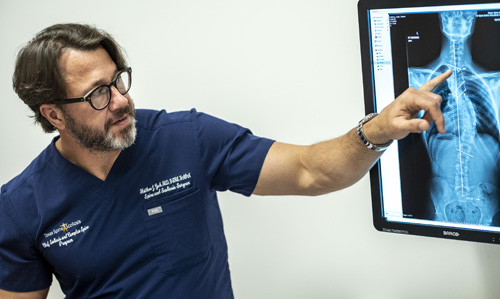 Surgery may be required in order to correct the spinal
curve. Surgery is usually only recommended for large, progressive curves
or in those patients who have nerve pain that steadily worsens. A curve of greater than 70 degrees can impair lung and abdominal organ function. These
surgeries can be extremely complicated, and a person should invest
a great deal of time in selecting a spine surgeon who subspecializes
in using the most current (fourth generation) corrective techniques.
As with any spine surgery, finding a doctor with experience in this
specific type of surgery is key.
Surgery may be required in order to correct the spinal
curve. Surgery is usually only recommended for large, progressive curves
or in those patients who have nerve pain that steadily worsens. A curve of greater than 70 degrees can impair lung and abdominal organ function. These
surgeries can be extremely complicated, and a person should invest
a great deal of time in selecting a spine surgeon who subspecializes
in using the most current (fourth generation) corrective techniques.
As with any spine surgery, finding a doctor with experience in this
specific type of surgery is key.
As with any disease, the sooner the problem is discovered,
the more treatment options there are available to arrest the progress
of the condition.
[Top]
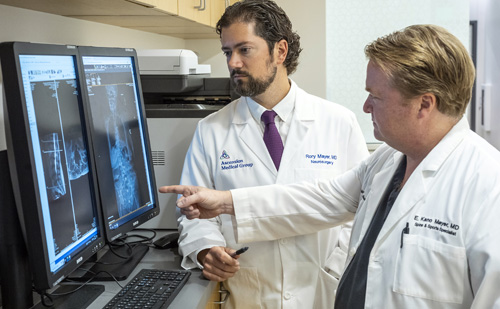
Your doctor will take X-rays of your spine which will reveal whether or not scoliosis is present as well as how severe it may be.
Scoliosis can be life-threatening when bones are so severely twisted that they compress vital organs. Surgery is most likely the best option in such cases. If left untreated, severe cases of scoliosis can shorten a person's life span.
There are some nonsurgical ways to treat scoliosis such as physical
therapy, exercise, bracing, shoe inserts and medication. However, only
a spine surgeon can determine if any of these options might apply to
you.
[Top]